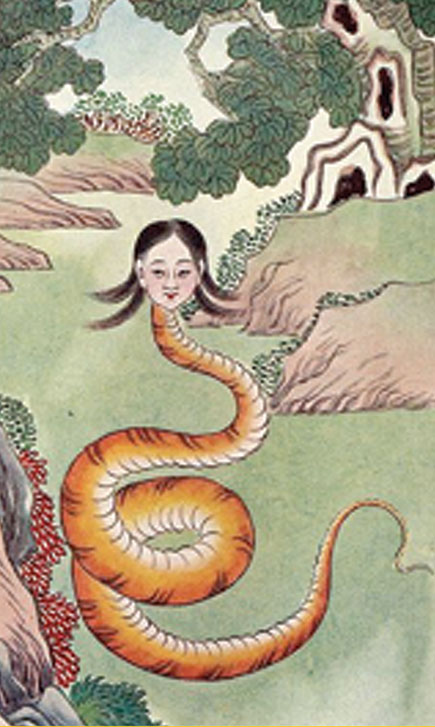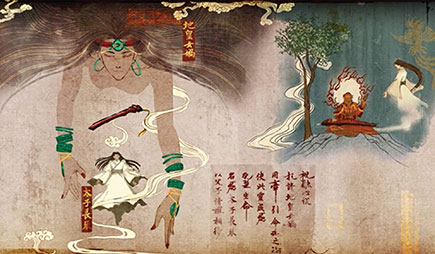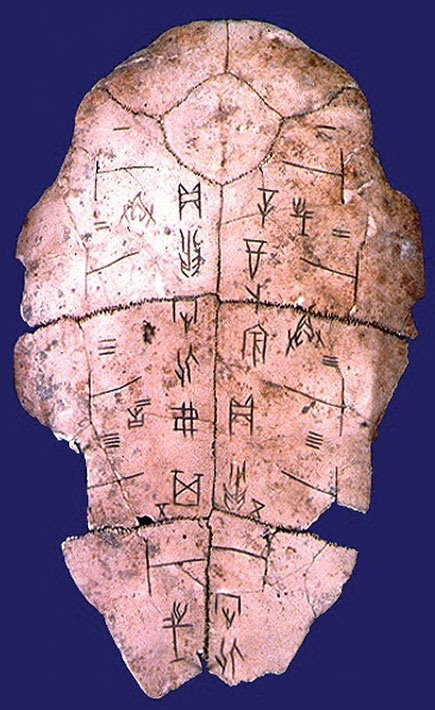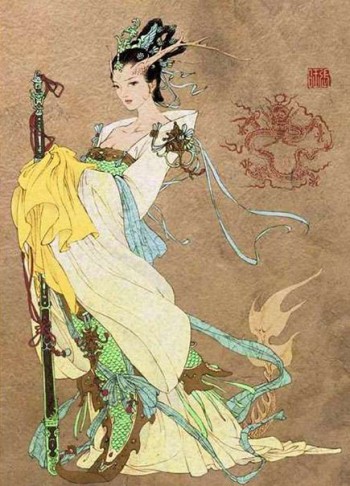Donna Carey, LAc
Orienal Medicine Journal, New Year/Year of the Snake 2013
Introduction
In the Year of the Water Snake it is appropriate to tell some of the earliest creation myths of ancient China, the legends of the female divinity Nü Gua, a snake goddess. Many of these stories were transmitted orally; the specific details are influenced by the evolution of culture and by the philosophical, religious, and political movements that influence the retelling, reorienting, and transforming of the narratives. These stories are filled with supernatural beings, woven into shamanic rituals, and grounded with the cosmogony of tribes and clans that were later adopted into mainstream dynasties and cultures.
The roots of these myths may well come from pre-history; however, there is evidence of their existence dating to the early Neolithic period in China. There is reference to Nü Gua in the late Neolithic period in China during the age of the Three August Ones. Later myths from the Han Dynasty depict Nü Gua and her companion Fu Xi, one of the Three August Ones, as brother and sister, husband and wife, worshiped as the progenitors and ultimate ancestors of humankind. Fu Xi and Nü Gua are often represented as half-snake, half-human.
Snake worship is attributed to the Xia clan, which dominated the Northern regions of ancient China in the Yellow River area around 2200 BC. These myths are similar to other creation myths from around the world. In China, over time, the snake became the dragon, which is one of the most enduring symbols of Chinese culture and mythology.
The ancient texts identify Nü Gua as the original ancestor of humanity, half-snake, half-human. She is the creator who molded humans from clay. When the pillar supporting the heavens was damaged, she repaired the sky. After the chaos of the flood, Nü Gua restored order to the world, provided stability, and populated it. She was responsible for the restoration of order and brought the five phases back into harmony. Her actions regulated the movement of all celestial bodies, restored the seasons, and recreated the axis mundi. To create harmony on Earth she fashioned musical instruments. The ancient Chinese matriarchal society revered and celebrated Nü Gua as the powerful creator goddess, and the practices continue to this day.
Although Nü Gua originally stood alone, similar to the shifts we find in the West in later texts and iconography, Nü Gua became paired with Fu Xi, who is identified as her brother, a creator god. Fu Xi is credited with the creation of the hexagrams of the I Ching and many other inventions. Nü Gua and Fu Xi are represented as intertwined snakes, the embodiment of yin and yang. They are depicted holding the instruments of creation, the compass and the square, the tools that were used to take the measurements of the Universe at the founding of a new world following the great flood (Nibley, 1992). Although there is disagreement among the texts, there is some evidence supporting the idea that Nü Gua was one of the Three August Ones. These legendary rulers served around 3000 BC to 2200 BC before the Xia dynasty.
Nü Gua is also linked to Yu the Great and the flood stories. In some myths she is his wife, and Yu is depicted as a dragon rather than a bear. In these stories it is Nü Gua who works with Yu to hold back the floods. Yu is awarded similar mythical doctrines and tools consistent with those of Fu Xi. Together Nü Gua and Yu repopulate the world and establish order. It is Yu who establishes dynastic rule and the rights of Kings. This union between Nü Gua and Yu is one example of the shift from the matriarchal culture of the snake goddess to kingship and patriarchal rule.
However, in the earliest creation myths from China, Nü Gua is an independent powerful goddess, the creator of humankind. She is a matchmaker, bestows fertility, invents sound and music, and brings harmony to heaven, earth, and humanity. She is a benefactor to people and all living creatures. However, just as we see in the West, the power of the strong female creator Goddess is diminished first by pairing her with a male God, and finally by attributing all of her creations to a male God who usurps her power. One example would be the legends of P’an Ku, the male Titan who splits heaven and earth and creates the world and humans from his own body.
In the Year of the Snake it is important to remember and honor Nü Gua, who represents an important aspect of the Chinese matriarchy, culture, and cosmology. She is the Great Mother of Humans, a cultural heroine, and one of the most powerful and influential primordial goddesses in ancient Chinese mythology.
The Myths of Nü Gua
Nü Gua is the Great Mother Goddess in matriarchal society since antiquity and belonged to a tribe in Northern China with names and connection to the snail. It is said she was formed like a human; but, instead of legs, she had a serpent’s tail to glide over the Earth. She also had a long head with two fleshy horns, and her body was that of a snail; she was originally worshipped as such. She is most often portrayed as a snake deity much akin to other cross-cultural mythologies linked with the snake and creation, to matriarchal primogenitors. Nü Gua is mostly depicted as half-human, half-snake (later half-dragon) and always as a semi-mythical and supernatural being. The mythical figure of Nü Gua as a creator God predates the male creator stories of P’an Ku in classical mythology by six centuries. She appears early in the tradition referenced in “Question of Heaven” in Chu Chi, Songs of Ch’u and in the Shanhaijing, The Classic of Mountains and Seas, in Fengsu Tonji, Popular Customs and Traditions, and later in records from the Han Dynasty, including many descriptive passages in the Huainanzi, a major repository for Chinese myths, and in the Shou Wen Jia Zi, Talking About Text and Explaining Words.
It is important to mention that while the written Nü Gua myths started appearing during the Han Dynasty (206 BC-220 AD), they were transmitted orally from a much earlier period. The first emperor of the Qin Dynasty (221-206 BC) burned a huge number of literary texts and old myths to exert cultural and political control. As with most book burnings, the losses were irreparable, since they contained mythic themes, archetypes, and symbols critical to the survival of its culture. The Han Dynastic scholars revised what was left and reclaimed the Nü Gua myths from non-orthodox history, legends, and folklore, and, of course, added their own twist to these stories.
Nü Gua existed in the beginning of the world before there were any people. Most sources concur that it was her loneliness that provided the impetus for creation. She walked plains and valleys and felt that the world was a very desolate place without animation. She began with making chickens which cluck through creation, then dogs to run through the forests and glades, sheep to graze in the plains, pigs to root through the earth, gentle cows, powerful bulls, then horses to run free. On the seventh day, while walking along a river, she glimpsed her own reflection. She sat beside the flowing waters and ran earth through her fingers, then took water from the river and yellow Earth and molded the clay as little creatures, which began to laugh. She loved the noise and so continued to make more creatures. As the creatures came to life, they called her mother and wandered the Earth to repopulate the world. She is a self-aware, independent, creative, and powerful feminine force.
At some point, Nü Gua was so exhausted that she realized it was not in her best interest to continue to fashion each person individually. So she took a rope (which later became a measuring cord on her compass) or, in some texts, a piece of ivy or a vine from the mountainside, dipped it into the yellow clay, and then tossed the drops and bits of mud to all the directions. Each drop contained the essence of a distinct human. The rich and the noble were those hand crafted from the yellow clay, and the poor and the ordinary were the manifestations of pulling the rope through the mud and flinging it. Later with the establishment of class and privilege, the hand created humans become nobility and the rope drops commoners, so it is not only telling of creation but of social hierarchy. There are detailed descriptions in the Feng Su Tong Yi, Comprehensive Interpretation of Customs, of Nü Gua’s intention of enrichment and beautification of the world through her creation of human beings, not necessarily the creation of social classes.
 In other variations of this myth, as Nü Gua listened to the laughter of her creations, she began to contemplate what would happen when they died. She was concerned that she would have to keep making more and more. It is written that she fashioned men and women in halves and taught them how to love one another so that they could repopulate the Earth. With this role she takes on the archetype of the first high matchmaker, the inventor of marriage, and comes to be identified as the goddess of marriage, fertility, and childbirth. Her temples were built near streams often depicted as the place of creation. Thus we see how she came to be identified in the classics of Chinese culture as the Mother Goddess, the Guardian Goddess, and a great matriarch. The snake in world mythology is believed to control the sources of water and is the hierophant of fertility and the creator of humans.
In other variations of this myth, as Nü Gua listened to the laughter of her creations, she began to contemplate what would happen when they died. She was concerned that she would have to keep making more and more. It is written that she fashioned men and women in halves and taught them how to love one another so that they could repopulate the Earth. With this role she takes on the archetype of the first high matchmaker, the inventor of marriage, and comes to be identified as the goddess of marriage, fertility, and childbirth. Her temples were built near streams often depicted as the place of creation. Thus we see how she came to be identified in the classics of Chinese culture as the Mother Goddess, the Guardian Goddess, and a great matriarch. The snake in world mythology is believed to control the sources of water and is the hierophant of fertility and the creator of humans.
Nü Gua and the Flood, Repairer of Heaven and Great Guardian of Human Life
The most detailed accounts that link Nü Gua with water relate to the story of the taming of the floods that is chronicled in the Huainanzi. During antiquity, the sky and the earth were in total chaos, and humanity was in danger of extinction:
In ancient times the four limits (of the world, si ji,) collapsed and the Nine Provinces split apart. Heaven did not completely cover the world, nor did the Earth support all things. Fires raged without going out and water surged on without ceasing. Fierce beasts devoured the simple people, and the birds of prey carried off old and young alike. Thereupon, Nü Gua smelted the five-colored stones to patch up the azure sky, cut off the turtle’s legs to reestablish the four limits, and killed the Black Dragon to rescue Ji Province (the central of the Nine Provinces, which in this passage stands for the entirety of China). She piled up ashes from the reeds to halt the rampant waters. Thus the azure sky was patched, the four limits corrected, the rampant waters dried up, Ji Province restored to order, and the treacherous creatures died. The simple people lived, walking on the back of the square provinces (Fang Zhou, i.e., Earth) and embracing the round Heaven (lewis, 2006, p. 111).
The accounts in this text are concerned with the ravages of the cataclysmic flood and the tipping of the sky, and with fires that are intense and raging—linking fire and water as parallel catastrophic events. Nü Gua blends colored stones to restore order to time and space and to save the world from the utter chaos of the flood. The five colored stones are linked to the Five Phases, internal and external alchemy, and were used for medical purposes in the Han to cure illness. Much earlier the Zhou Li states: “In all cases of treating sores, use the five poisons, to attack them, use the five energies to nourish them, use the five medicines to treat them, and the five flavors to regulate them” (Lewis, 2006, p. 112).
The five poisons refer to the active ingredients, five minerals of five different colors, and the five medicines are the five stones, assimilated into the standard set of the five minerals that are used to patch up the sky and treat the body. They are also considered an important aspect of alchemical casting of metals for a proper marriage between fire and water. The earliest known inscription for rectifying the body through balancing the circulation of qi is an inscription carved on a piece of jade. Jade is said to be the only stone unused by Nü Gua because of its sacredness and ability to bring protection, healing, and balance by its mere presence.
Nü Gua had many roles—far beyond the restoration of the world to order and harmony. She is also credited with setting the seasons and reestablishing the poles. She became a savior figure and presided over the protection of humanity and reemergence through the granting of new life, namely the permutation of the fetus into life. She also captured and joined the energies of the sun, linked humanity with the heavens, and connected the macrocosmic with the microcosmic, fire and water. She presided over the relations of marriage metaphorically, alchemically, and literally. Later Taoists believed she alone holds the secret of the Way of the True Person and follows the eternal nature of Heaven and Earth.
There is a second and later version of the Flood myth in which Gong, the water dragon, destroyed one of the pillars supporting the sky, which caused cosmic chaos. A black hole in the celestial vault resulted in torrential rains and fires, and floods raged everywhere. Nü Gua melted stones of different colors and patched up the sky. She used a tortoise for support of the world, slayed the Black Dragon, and collected ashes and reeds to stop the flood. She mended the sky and repaired the earth from this disaster. The multihued clouds in the sky are from the colorful stones she used to patch the sky. The reason that western China is mountainous and the east lower is because she used the longer legs of the tortoise to support the west and the shorter ones for the east. In this version of the cataclysm the damage is permanent; the earth’s pillar is damaged and points northwest. There is a cosmic flaw, and this is why Chinese rivers flow towards the east. It also suggests that the cosmic order is disrupted through male violence and restored through female benevolence.
 Selecting several stones from a river, Nü Gua shaped them to repair the hole in the sky.
Selecting several stones from a river, Nü Gua shaped them to repair the hole in the sky.
She also slew a giant tortoise and used its legs to support the heavens. Nü Gua’s
actions restored the order of the universe and saved the world from destruction.
Nü Gua and Music
Nü Gua is credited with the invention of various musical instruments, including the shenhuang, a reed pipe wind instrument, and the xiao, a vertical bamboo flute, as well as many reed and wood instruments fashioned from organic materials. One part of her work for restoring the world was to create harmony between heaven and earth. She achieved this by gathering the ashes of reeds to stop the devastating floodwater. In later accounts of her subsequent death and transformation into a jingwei bird, she carried wood and stone to construct a dike against the raging Eastern Sea. In many sources, Nü Gua is said to have ruled through the mythic powers of wood to balance the element of water, whether in slaying the black dragon, or in using reeds or wood to control the floods. Her work in restoring harmony through music is also a cultural innovation, and many stories say that Nü Gua invented music and musical instruments to entertain the children she created.
Nü Gua and Fu Xi in Modern Mythology
Joining the myths of Nü Gua and Fu Xi marks the beginning of the suppression of female power in China. This change begins around the time of transition from the early Han to the later Han Dynasties. It is a period that is marked by military expansion. Nü Gua begins to be paired with the mythic figure, Fu Xi; and they are represented as a married couple and as patrons of marriage as an institution. Han iconography depicts these two as a primal couple who restored and populated the earth after the flood. They are both linked to snake or dragon spirits and to themes of creation. They are guardians of transformations, gatekeepers between the inner and outer, and protectors of tombs and of the crossing of boundaries from one state to the other.
A different rendering of the origins of humans appears in the Duyizhi, A Treatise on Strange Beings and Things that involves Nü Gua and Fu Xi’s brother-sister tryst. The myth is set at the very beginning of the world. The sole inhabitants are a girl and her older brother who reside on the mythic Kunlun Mountain. Although they wanted to marry to reproduce, they were shamed because of their blood connection. They plead and send prayers and declarations from the top of the mountain. “Oh heaven if thou wouldst send us two forth as man and wife, then make all the misty vapor gather. If not make all the misty vapor disperse” (from Tu, yi chih, Birrell, 1993, p. 35).
Of course, the prevailing winds worked in their favor and gathered and united the vapors—so they were wed. In other accounts the vapors are smoke snakes and rings. Nü Gua is depicted as very shy and ashamed. She gathers reeds and grasses to weave into a fan to cover their faces. So we see both shame and guilt about intercourse, no fig leaf, but incest. The difference here between Adam and Eve is that their union is condoned and receives the stamp of approval. This custom of brides holding fans over their faces during wedding ceremonies persists today.
There are many other accounts of the coupling and creation, including the use of clay to create human figures and the power to animate them, and countless local folktales and myths about the signs for the go ahead to marry and join forces. Remember that childbirth in more primitive times was rather miraculous, not requiring male participation—and children knew only their mothers. As the reproductive process became more obvious, ancient China moved toward a patriarchal structure, and Fu Xi became an icon of the utmost importance.
We can safely say that Nü Gua’s divinity was suppressed—her independence eroded. Her divine pairing with Fu Xi is similar to Zeus and Hera in the Greek pantheon. Edward S. Shafer (1973), a prominent American Sinologist and Tang Dynasty scholar, states: “Her gradual degradation from her ancient eminence was partly due to the contempt of some eminent and educated men for animalian gods, and partly due to increasing domination of masculinity in the elite social doctrine” (p. 29).

Nü Gua the Earliest Ancestor
The Balance of Yin and Yang, Fu Xi and Nü Gua
Fu Xi invented a writing system by carving small pictures
and numbers onto bones and tortoise shells.
Fu Xi is depicted as a major deity and helper to humanity. Although some myths articulate his primal coupling with Nü Gua, he also stands alone as a separate powerful creator deity. But perhaps the greatest legacy of Fu Xi is that he shared mythic attributes with Nü Gua which may well have provided a foundation for the development of the Han yin/yang cosmology, which facilitated our understanding of the interdependence between the male and female.
Fu Xi appeared in the Han as the first in a lineage of sages and, more specifically, sagekings. He is credited with being the creator of the trigrams of the I Ching. His direct connection to and contemplation of the natural world revealed to him the theory for complementarity. This concept of complementary pairs is the very foundation of the Universe, as their dynamic balance and tension lead to change and transformation.
When Fu Xi ruled the world in ancient times, he looked up to examine the images in Heaven, and down to examine the models on Earth. He examined the markings of the birds and the beasts, and their suitability to the terrain. Near at hand he took it for himself, and at a distance, from objects. Therefore he created the eight trigrams in order to communicate with the powers of spirit intelligences, and in order to categorize the natures of myriad objects. He invented knotting cords to keep records and made nets and snares for hunting and fishing. He took this form from the hexagram li (from Treatise of the Yi Jing, lewis, 2006, p. 117).
Fu Xi is the ultimate progenitor of human technology, as evidenced through his invention of the trigrams of the I Ching. He is also credited with the invention of the calendar, writing, and numbers. Ruling jointly with his wife Nü Gua, we are provided with the foundational spirit for yin and yang, sun and moon, birds and beasts, and the distilling of all things into categories. He taught humanity survival skills such as fishing, creating nets, and tool making and was said to have brought the Great Waters of the Universe into order by digging dikes, canals, and irrigation ditches to tame the Yellow River. He, like Nü Gua, is credited with the invention of musical instruments, such as the guqin, a seven-stringed musical instrument, and the pipa, a lute, which he taught people to play to accompany the telling of stories. Fu Xi is a major force in his own right. He received The Yellow River Chart from creatures that rose out of the Yellow River and the Luo Writings, which are the Lou Shu Emergence that provide the knowledge for the organization of time and space. It is said that he discovered the trigrams on the back of a tortoise.
 United as the divine creators of the world, Fu Xi and Nü Gua hold back the floods and provide the structural and the functional principles of an ordered world. The best-known image of Fu Xi and Nü Gua appears in the Wu Liang shrine where they are co-creators of the world. Their intertwined serpent bodies rotate around an invisible vertical axis mundi (cf. Santillana and Dechend, 1969). Fu Xi holds the carpenter’s square used to establish divisions and create the trigrams, and Nü Gua has a compass, to restore the circular heaven to its place (Nibley, 1992). These tools are complements, as the square is associated with the feminine principle of earth and the circle with the masculine principle of heaven, and are used for taking the measurements of the world, for keeping order in the world.
United as the divine creators of the world, Fu Xi and Nü Gua hold back the floods and provide the structural and the functional principles of an ordered world. The best-known image of Fu Xi and Nü Gua appears in the Wu Liang shrine where they are co-creators of the world. Their intertwined serpent bodies rotate around an invisible vertical axis mundi (cf. Santillana and Dechend, 1969). Fu Xi holds the carpenter’s square used to establish divisions and create the trigrams, and Nü Gua has a compass, to restore the circular heaven to its place (Nibley, 1992). These tools are complements, as the square is associated with the feminine principle of earth and the circle with the masculine principle of heaven, and are used for taking the measurements of the world, for keeping order in the world.
Ancient painting of Nü Gua and
Fu Xi unearthed in Xinjiang.
The union between Nü Gua and Fu Xi might be viewed as the first sacred marriage, the joining of two equal powers that provides order and structure to the cosmos. Their bond bestows a foundation to understand the connections among Heaven, Earth, and Humanity. As co-creators they give birth to The Three Treasures. They are the guardians of the tombs, gatekeepers of the sacred waters, twin snakes of life and death; they have the power to transform, regenerate, and
create. Their paired bodies provide the creation of all origins, the DNA of life, including the trigrams, hexagrams, protein bases, and the fertile water from which all life emerges. Together they are yin and yang; they control the floods, pole shifts, and soul shifts, wind and rain, fires and alchemical gold. This is the mystic marriage of heaven and earth, the creation of an ordered and dependable cosmos, the foundation of the collective identity of all people.
There is a word in modern Chinese, a phrase really, kuci chu; and it signifies “the way things should be, the moral standard.” Literally it means the compass and the square. May we embody both Nü Gua and Fu Xi striving always to restore and maintain the sacred and constant balance among heaven, earth, and humanity.
References
Birrell, A. (1993). Chinese mythology: An introduction. Baltimore: The Johns Hopkins University Press.
Cheng, C.M.B. (2004). Matriarch at the edge; The mystic cult of Nu Wa in Macau, Hong Kong. Paper presented at 17th Triennial Congress of International Comparative Literature Association, August 2004.
Christie, A. (1983). Chinese mythology. New York: Peter Bedrick Books.
Lewis, M. E. (2006). The flood myths of early China. Albany, NY: State University of New York Press.
Fu Xi, New World Encyclopedia, Accessed January 7, 2013, http://www.newworldencyclopedia.org/entry/Fu_Xi
Nibley, H. (1992). Temple and cosmos. Salt Lake City, Utah: Deseret Book Company.
Santillana, G. & von Dechend, H. (1969). Hamlet’s Mill, Boston: Nonpareil Books.
Schafer, E. H. (1973). The divine woman: Dragon ladies and rain maidens in T’ang Literature. Berkeley: University of California Press.
Yang, L. & An, D. (2005). Handbook of Chinese mythology., New York: Oxford University Press.
Zhi-Xiang, N. & Echlin, K. (1986). The Gods of earliest creation, an excerpt from Dragons and dynasties. Beijing: Foreign Language Press.

